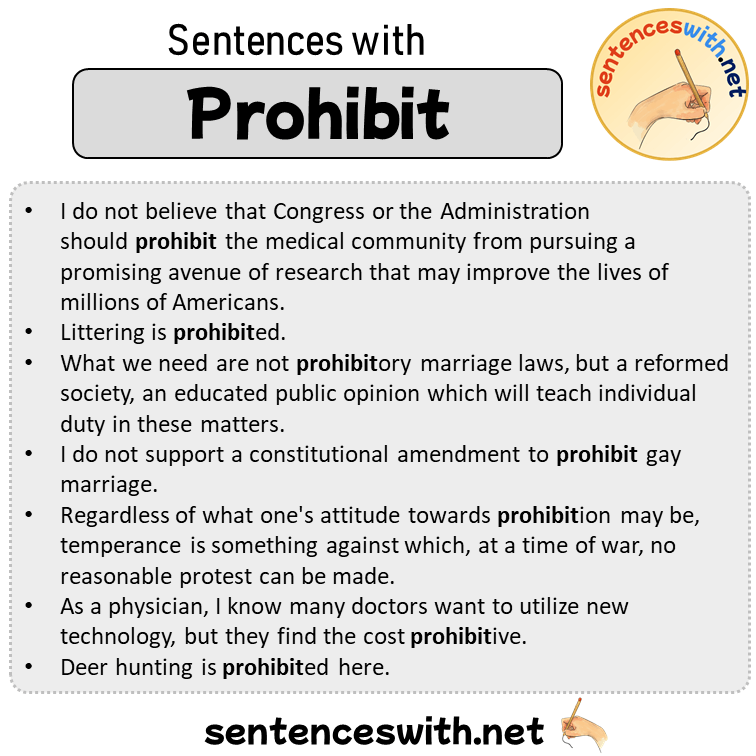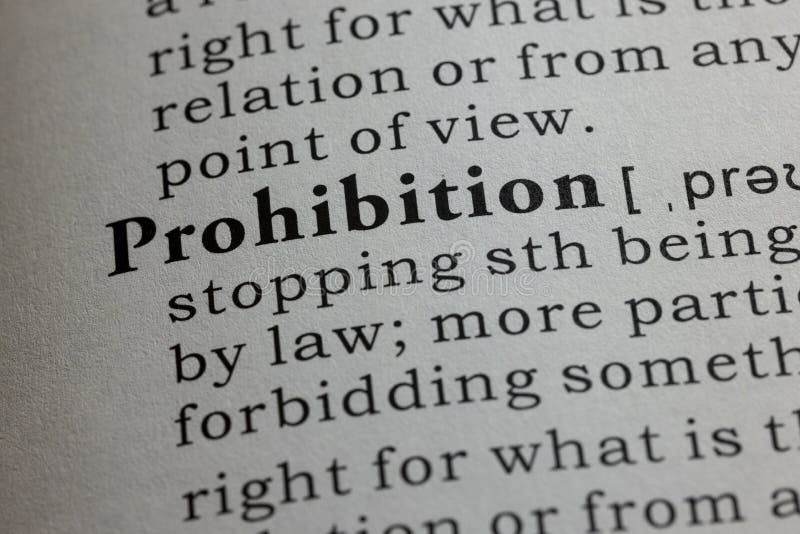Use the phrase prohibit in a sentence. Crafting the right sentence utilizing “prohibit” requires extra than simply plugging the phrase right into a sentence; it is about understanding the nuances of its software. This exploration dives deep into developing efficient sentences that showcase the total impression of this highly effective phrase.
Understanding the delicate variations in which means when utilizing “prohibit” is essential to crafting impactful sentences. Think about the context, the specified tone, and the particular motion being forbidden. This information will stroll you thru numerous eventualities, from formal authorized contexts to on a regular basis conversations.
Understanding how you can successfully use the phrase “prohibit” in a sentence is essential for clear and concise communication. This complete information delves into the nuances of this highly effective verb, exploring its numerous purposes and offering a wealth of examples for example its utilization. We’ll cowl not solely fundamental sentence buildings but in addition delve into extra advanced eventualities, making certain you grasp this phrase’s delicate meanings.
Understanding the Core Which means of “Prohibit”
At its coronary heart, “prohibit” means to formally forbid or forestall one thing. It suggests a transparent and authoritative restriction, usually backed by guidelines, laws, or legal guidelines. This formal nature distinguishes it from different phrases like “forestall” or “forbid,” which can not carry the identical weight or implication of official sanction.

Key Traits of Prohibitions
Prohibitions usually contain:
- Formal Authority: Prohibitions sometimes stem from a governing physique or authority determine.
- Clear Intent: The aim of a prohibition is explicitly acknowledged to keep away from ambiguity.
- Enforcement Mechanisms: Prohibitions are sometimes accompanied by techniques for enforcement and penalties for violation.
Crafting Efficient Sentences with “Prohibit”
To make use of “prohibit” successfully, think about the context and the particular nuance you wish to convey. Listed here are some examples demonstrating numerous makes use of:
Easy Prohibitions
Instance 1: The varsity prohibited college students from bringing cell telephones to class.
Instance 2: The native council prohibited the parking of autos on Fundamental Road between 8 AM and 6 PM.
Prohibitions with Particular Causes
Instance 3: The town prohibited using fireworks as a result of danger of wildfires.
Prohibiting sure actions usually requires cautious consideration. As an example, fixing a crossword puzzle, like discovering the 6-letter reply for a “Turkish peak” here , might sound innocuous, however in a particular context, it could possibly be prohibited. This highlights the significance of exact wording when utilizing the phrase prohibit in a sentence.
Instance 4: The corporate prohibited smoking in all indoor areas to advertise worker well being.
Prohibiting sure actions is essential in lots of contexts. Understanding the idea of “incomes your preserve,” as explored on this useful information on earn your keep meaning , highlights the significance of demonstrably contributing to a bunch or system. Successfully utilizing the phrase “prohibit” in a sentence hinges on clear context, emphasizing the restrictions positioned on sure behaviors.
Prohibitions Implying Penalties
Instance 5: The brand new legislation prohibited the sale of unpasteurized milk, resulting in elevated well being requirements and client safety.
Instance 6: The laws prohibit using dangerous chemical compounds in manufacturing processes, thereby making certain environmental security.
To successfully use the phrase “prohibit” in a sentence, think about its context. As an example, an area ordinance would possibly prohibit skateboarding in sure areas. Crucially, understanding the alternative of “wsw” in a crossword puzzle, as seen in this resource on the opposite of wsw crossword clue , may also help you craft extra nuanced sentences that precisely replicate the meant which means.
In the end, mastering using “prohibit” depends upon an intensive understanding of its nuances and context.
Nuances and Variations in Utilization
Whereas “prohibit” typically means to forbid, its software can subtly shift primarily based on context. Think about these nuances:
Passive Prohibitions
Instance 7: The foundations prohibit the entry of unauthorized personnel.
To ban one thing successfully, think about the context. As an example, a brand new regulation would possibly prohibit sure actions in a particular zone. Understanding the nuances of “caught in 4K,” a time period more and more utilized in digital contexts, will also be useful for crafting efficient sentences that make use of the phrase “prohibit.” what does caught in 4k mean This deeper understanding enhances your capacity to make use of “prohibit” precisely and persuasively in numerous eventualities.
Prohibitions as a Type of Restriction, Use the phrase prohibit in a sentence.
Instance 8: The contract prohibited the discharge of confidential data to exterior events.
Prohibitions as a Type of Authorized Constraint
Instance 9: The legislation prohibits the driving of autos inebriated.
Prohibiting sure actions usually requires cautious consideration. For instance, many laws prohibit harmful actions, akin to working heavy equipment with out correct coaching. This ties right into a broader linguistic exploration of concise phrase decisions, like exploring the multitude of three-letter phrases beginning with “b” here. In the end, selecting the best phrases, even brief ones, is essential to successfully speaking advanced concepts and laws.
Avoiding Frequent Errors: Use The Phrase Prohibit In A Sentence.
Utilizing “prohibit” appropriately entails understanding its formal and authoritative nature. Keep away from utilizing it in informal or casual settings, or when a much less stringent time period like “forbid” or “forestall” is perhaps extra acceptable.
Conclusion
Mastering using “prohibit” permits for exact and impactful communication. By understanding its core which means and the nuances of its software, you possibly can craft sentences that successfully convey formal restrictions and prohibitions. Keep in mind to think about the context and the specified degree of ritual when utilizing this highly effective phrase.
[See also: Advanced Sentence Structure Techniques]
[Image: Table comparing the use of “prohibit” vs. “forbid” in different contexts]

To additional improve your understanding of this matter, discover associated articles on efficient communication and using sturdy verbs. Share your ideas and questions within the feedback under.
[See also: Choosing the Right Verbs for Impactful Writing]
In conclusion, utilizing “prohibit” successfully requires a nuanced understanding of its numerous purposes. From authorized mandates to on a regular basis directives, mastering the artwork of incorporating this phrase right into a sentence elevates your communication. The important thing takeaway is precision and readability. Keep in mind the context and desired impression to wield this phrase with confidence.
Query & Reply Hub
How can I take advantage of “prohibit” in a proper authorized context?
In formal authorized settings, “prohibit” is commonly used to explain actions explicitly forbidden by legislation. For instance, “The statute prohibits using unregistered weapons.” This clearly establishes a authorized restriction.
What are some synonyms for “prohibit”?
Synonyms for “prohibit” embrace “forbid,” “ban,” and “forestall.” Nonetheless, every synonym carries a barely totally different connotation. “Forbid” is commonly utilized in a extra private context, whereas “ban” sometimes applies to broader restrictions. Understanding the nuances of those options helps tailor your language to the particular scenario.
How can I take advantage of “prohibit” in a sentence about an organization coverage?
Firm insurance policies usually use “prohibit” to Artikel restricted behaviors. For instance, “The corporate coverage prohibits workers from utilizing firm assets for private achieve.” This clearly communicates the corporate’s expectations.
